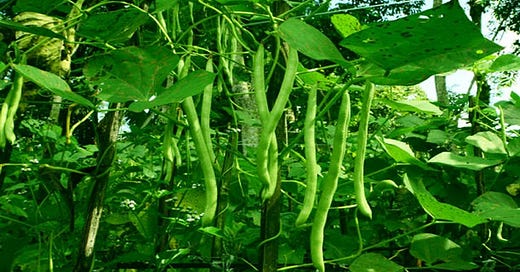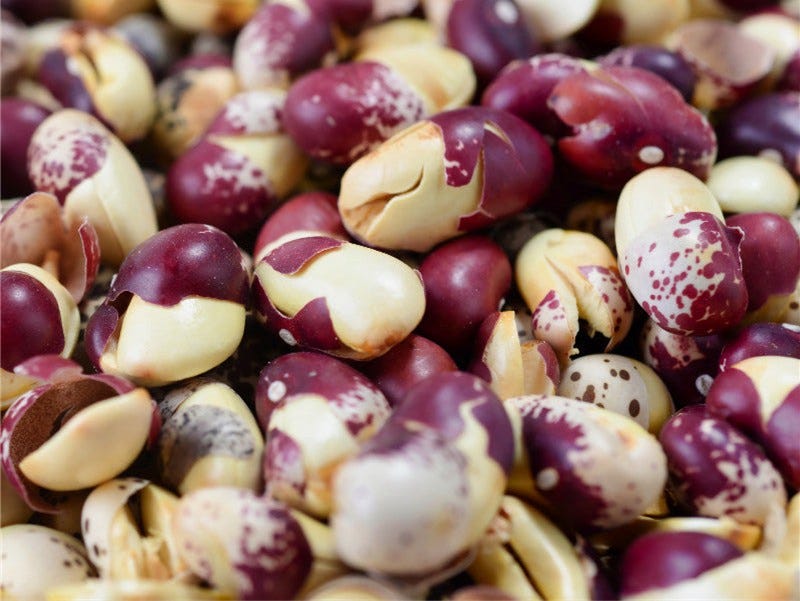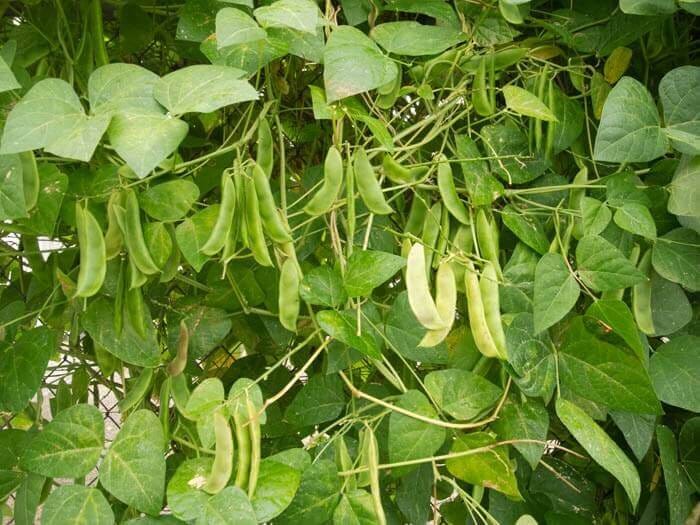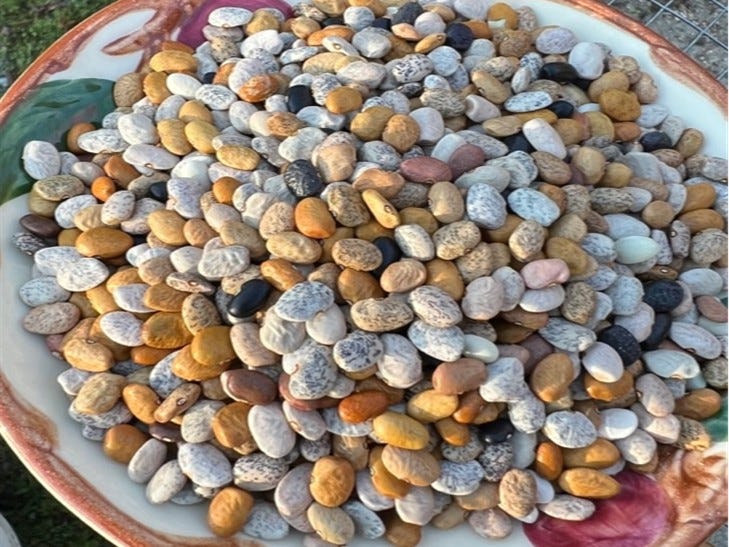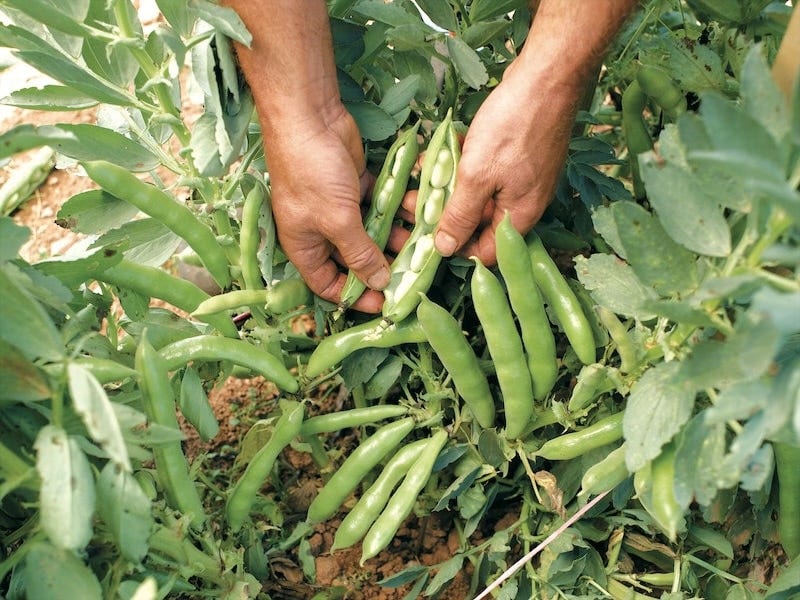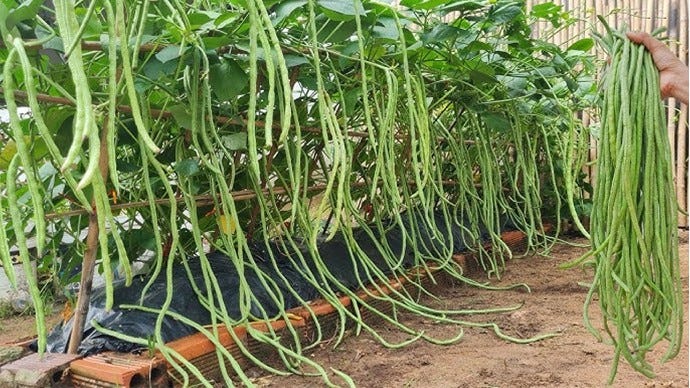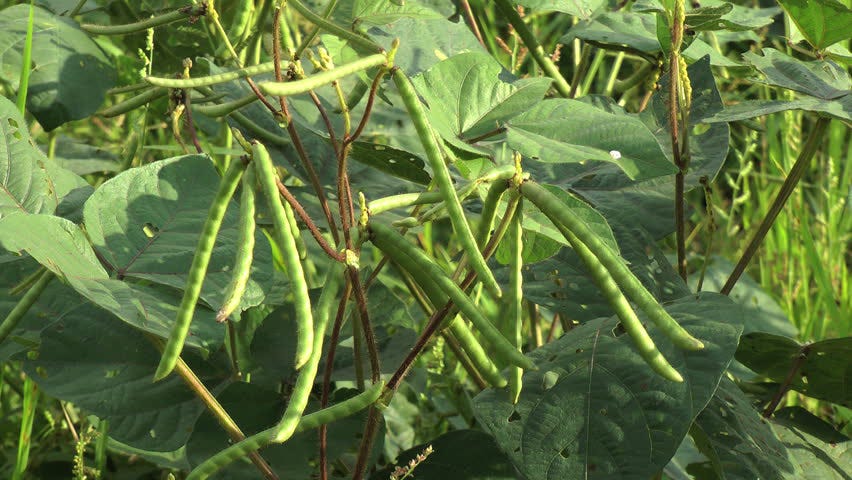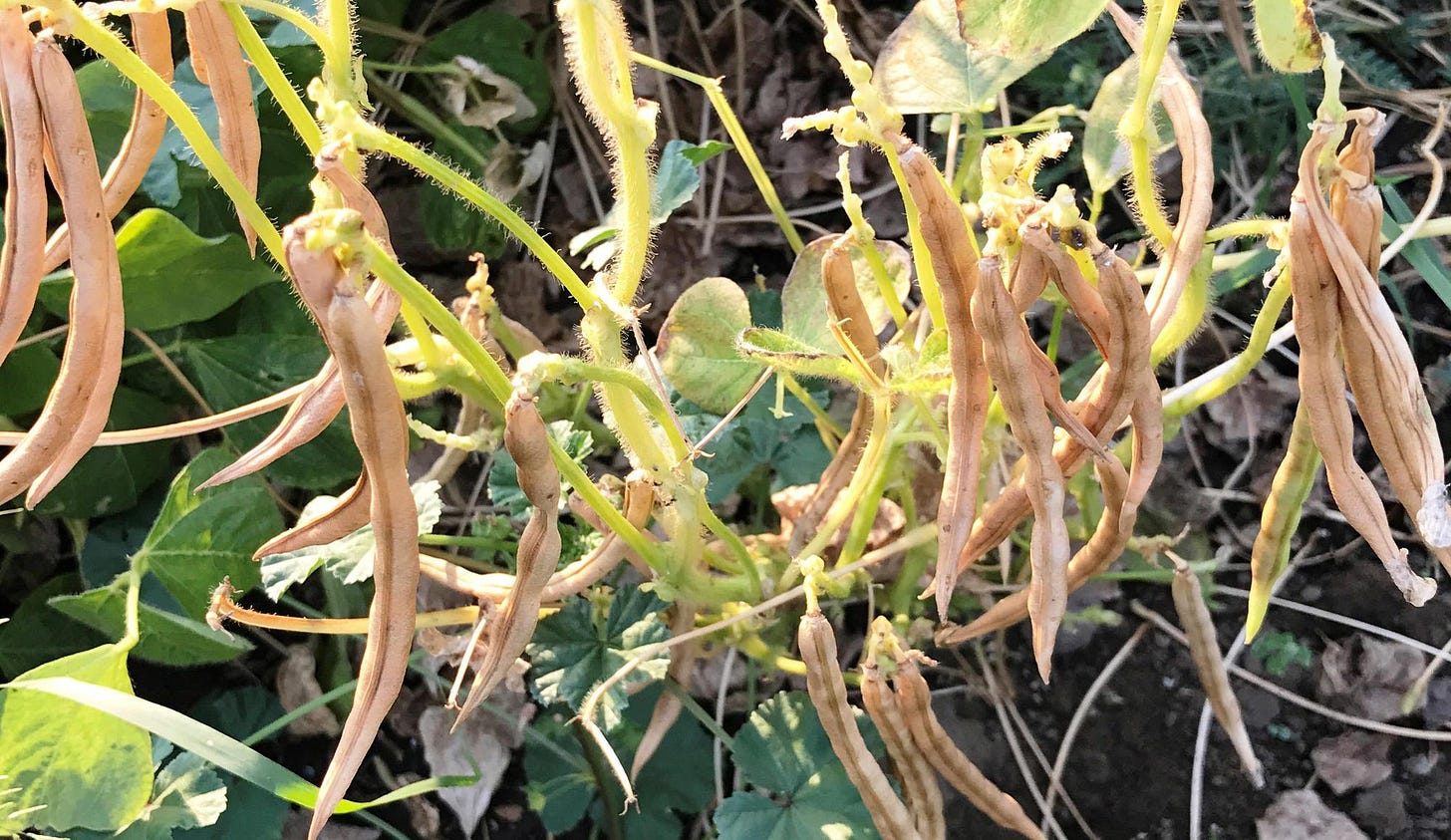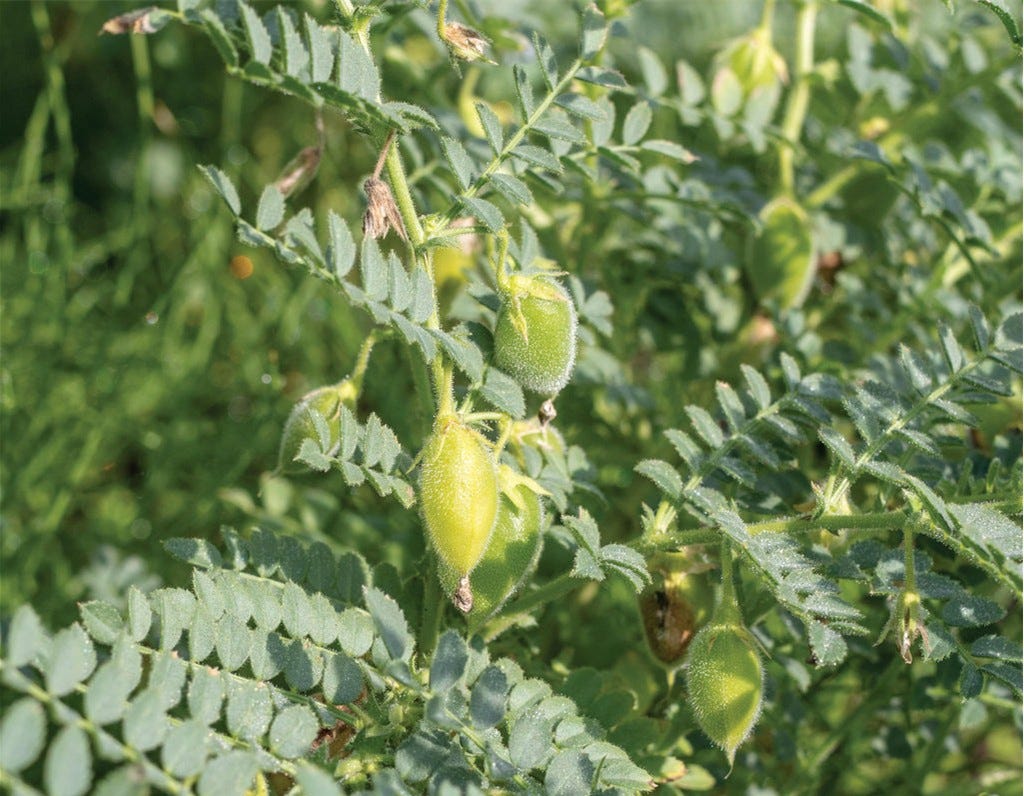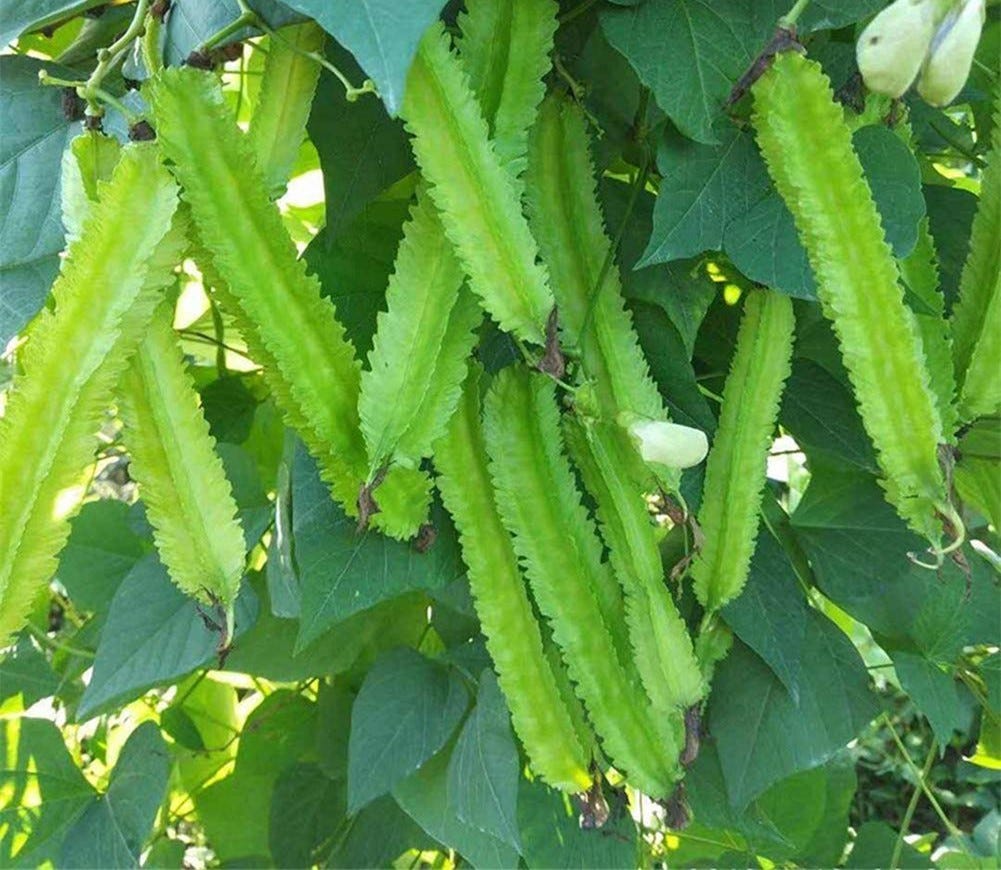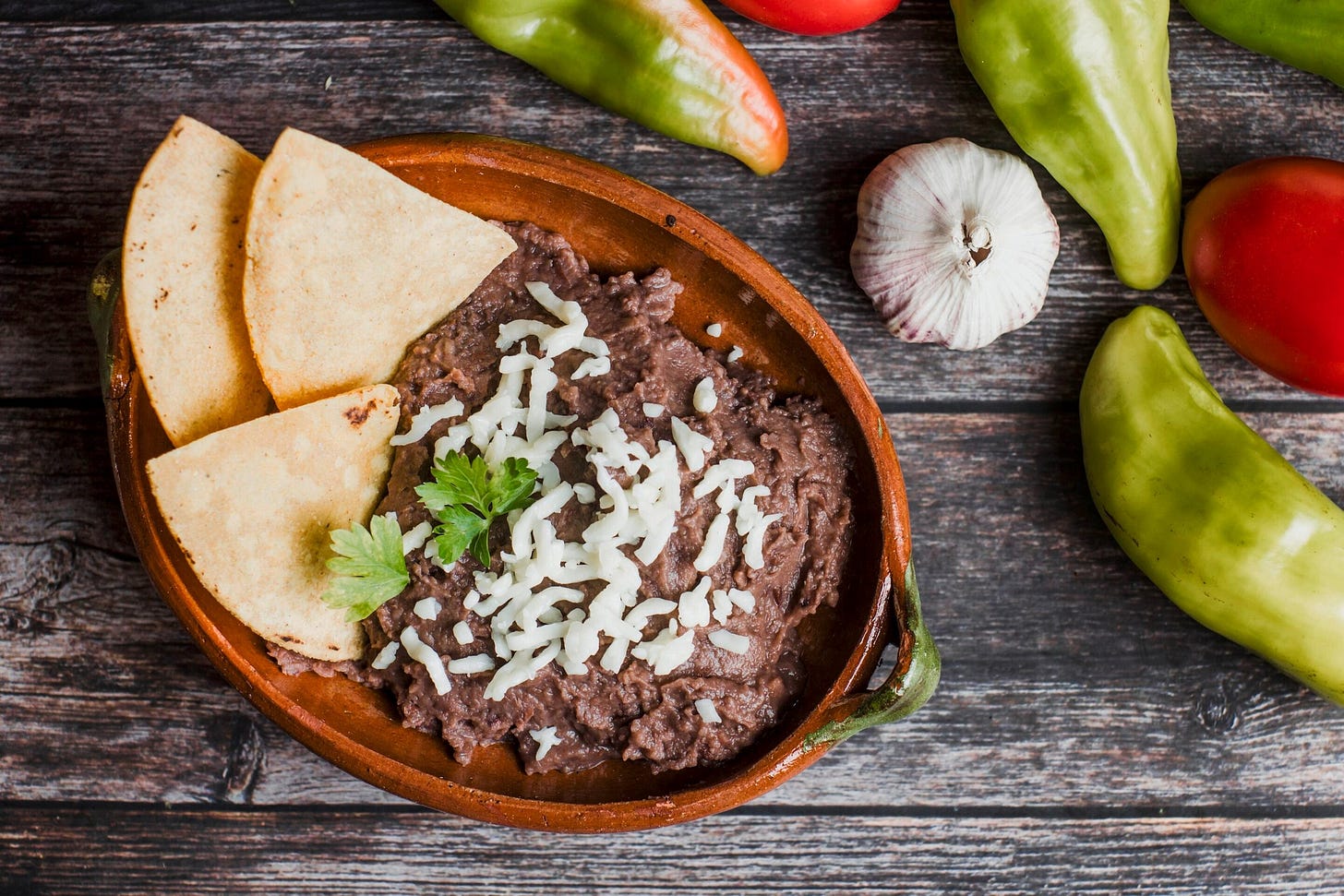Just about everyone likes beans. The kitchen folk like the tastes, the nutrition, the multitude of uses, and the overall ease of cooking. The garden folk like the many types and varieties, the generally easy care, the nitrogen-fixing ability, and their efficient use of space (for almost all). Lucky for us all, there’s a huge variety of beans available.
There’s an adequate smattering of only the most important growing guidelines here. Others* cover the growing aspects so well that I’ve decided to elaborate with some key botanical information, a wee bit of culinary tips, some oddball facts here and there, and my usual amount of fun stuff. Mostly, I think I wanted to share the diversity of beans available to home growers. Oh, and then there’s that thing about the rhyme.
[* Those other points of view (the growing details) are linked at the end of this article.]
From my point of view, let me start with what everyone thinks of first when one says simply “bean…”
THE “COMMON BEAN”
(Phaseolus vulgaris)
Also known as green bean, snap bean, or French bean.
Within this very basic, very common bean are types or categories of beans, some green, some not:
The most common, the string or snap bean, may have a round pod or a flat pod. It gets the name “snap” from the sound a fresh one makes when you bend it just right and it breaks neatly.
Although still called “string beans” by many, the “strings” have been bred out of almost all varieties now, including those available at supermarkets (although I’ve purchased my share of somewhat stringy greeny beanies).
The term “French bean” has a simple origin. The Columbian exchange brought “string” beans to the Old World, the Portuguese or Spanish shared them with France, the French selected stringless types, and the French then shared these “improved” beans with the British, who had a chance to call them, more appropriately, Mexican-Peruvian beans, but went, instead, with the stringless French version of that. I suppose, too, they could have called them “exotl,” the Nahuatl (the indigenous language of the Aztecs) word for the stringy green beans. These non-stringy beans, when picked young and thin as ideally they should be, are regarded in France as “haricot verts” (which essentially translates to “green beans”).
Flat beans (once considered a different species Phaseolus compressus and now a synonym of P. vulgaris) have wide and flat edible pods (don’t let them swell with mature beans). This type includes Romano beans (large Italian beans, including cannellini and helda beans; eaten fresh or dried), baguio beans (a Filipino specialty), and sem fhali, which are Indian beans also known as “runner beans” in some Indian states (but not to be confused with Phaseolus coccineus).
Drying beans (those grown to be stored) include some of the most common beans found in cans on grocery shelves: cannellini, pinto, black bean, navy, great white northern, and kidney. If you feel like searching Mexican markets, keep an eye out for mayocoba beans (also known as canary beans [canario], and Peruvian beans [peruano]) – I think these are the tastiest of dried beans and if you buy the bulk dried offering, you will save a TON of bread, cabbage, lettuce, etc.].
Some growers categorize drying beans purely by color; a few examples:
White beans: Navy, Great Northern, Cannellini, Haricots (not haricot verts),
Red beans: Kidneys, Pink beans, Cranberry beans
Black beans: Frijoles Negro (black beans)
Brown beans: Swedish beans (Bruna Bönor), Pintos (sometimes considered “red”)
Among the drying beans is a subgroup that were called, in the past, “horticultural beans.” These beans have long, somewhat-flattened pods splashed or dotted with cherry-red and/or white, and white or buff-colored seeds marked with various shades of red. Some of the very popular varieties include ‘Borlotti’ (‘Speckled Cranberry’), ‘Tiger’s Eye’, ‘Jacob’s Cattle’ (‘Trout’), plus ‘Pinto’. These all lose most to all of their coloring during cooking.
A special drying bean is the flageolet bean, a French selection (haricot) differentiated from other dried beans by being picked before full maturity and then dried out of the sun so it retains its green color when dried. Varieties include ‘Chevrier’ (the type name give to the bean originally grown this way) , ‘Elsa’, ‘Flagrance’, ‘Flagrano’, ‘Flambeau’, and ‘Flamingo’. Several other varieties may be found, each with a name indicative of the color (besides green).
Almost all members of Phaseolus vulgaris are available in two growing types based on “height:” bush (mounding to semi-climbing about 1- to 2-feet high) and pole (climbing to 8 to 12 feet or more)
Not only do the beans inside come in several colors, the pods have their own palette. Some have a purple pod (fun in the garden but it cooks to green, so…) and there’s the yellow (sometimes almost white) beans we call wax beans.
Beans for drying are for gardeners with plenty of spare space and time to justify growing them. Once shelled, the “yield by weight” (per square foot) drops quite a bit. There’s a process to shelling and drying them. Plus, important to many gardeners, there is no “fresh-from the garden taste” advantage to these. I rarely recommend going to the store to buy your vegetables, but for dried beans, you’ll find an attractive price, organically-grown options, and a remarkable variety selection at the larger stores, particularly those who have a bulk section, and very especially the Latin markets.
Fun culinary fact: the “flor de frijol” (bean flower) is edible and used favored in Latin dishes.
.
NUÑA, POPPING BEAN
(Phaseolus vulgaris ssp. nunas)
This oddball subspecies of Phaseolus bears round, multicolored seeds that resemble tiny pigeon eggs. When dried beans are cooked on high heat, they explode, exposing the inner part, in the manner of popcorn and other puffed grains.
.
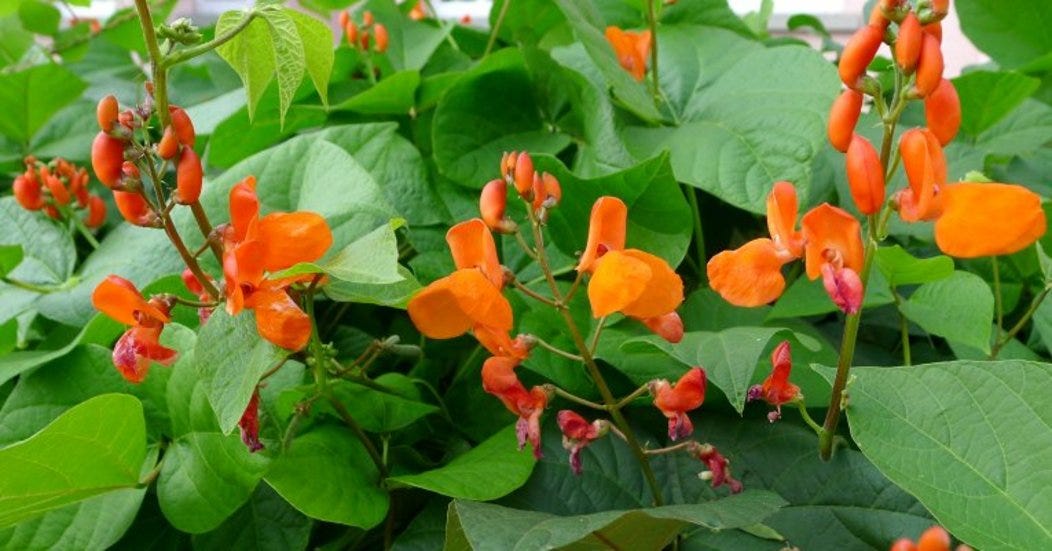
SCARLET RUNNER BEAN
(Phaseolus coccineus)
Because of its bright scarlet flowers, along with its lush foliage, this bean is more often grown simply for ornament and/or as an attractant for hummingbirds. But its pods (beautifully purple in some varieties) are quite edible, eaten whole while young and not yet fibrous, and the seeds (beautifully pink or speckled) can be used fresh or as dried beans.
Among the better, edible varieties: ‘Butler’ (stringless), ‘Hammond’s Dwarf’ (bush), ‘Moonlight’ (stringless), ‘Pickwick Dwarf’ (bush), and ‘Polestar’ (stringless). There is one outstanding group of regional varieties from Greece that bear white blossoms and gigantic white beans; they are known as fasolia gigantes (φασόλια γίγαντες). Although they are usually sold unnamed, beyond just “Giant Beans,” in some parts of Greece, they are grown and named under protective law where they have been granted a Protected Geographical Indication (PGI) by the European Union (much like the DOP designation for various foods in Italy). Baked with tomatoes seasoned with onions, olive oil, parsley, and carrots, these beans become “Gigantes plaki” (giant baked beans, although “plaki” can also mean “giant’s plate”).
Unlike most beans, it can be planted in spring and produces well during cooler weather. It does stop setting in summer heat, but if planted early, it can produce new flowers and pods in fall. Scarlet runner bean also acts as a perennial in mild climate zones such as 9 and 10 but sometimes in 8 (especially in well-drained soils and if kept mulched).
Very closely related to the common bean and scarlet runner bean is Phaseolus dumosus (or, more accurately now, Phaseolus × dumosus), the YEAR BEAN or YEAR-LONG BEAN. Along with the many other beans, it was domesticated in ancient times and only recently was determined to be a hybrid between Phaseolus coccineus, the runner bean, and P. vulgaris, the common bean; no determination yet as to whether it was a natural hybrid or a human intervention. Its characteristics are intermediate between the two parents including its blended habit of being an annual that sometimes acts like a perennial.
.
LIMA BEAN and BUTTERBEAN
(Phaseolus lunatus; the domesticated variety is P. l. var. lunatus)
The immature seeds of limas and butter beans are uniformly green but they age to white or yellowish. Some uncommon varieties have black, red, orange, or variously mottled seeds. As with common beans, these beans are available as both bush (at about 2 to 3 feet) and pole (6 to 16 feet-high) types. The bush varieties mature earlier than the pole varieties.
A MESS OF NAMES AND INTERPRETATIONS
Depending on who you talk to:
A good authority states that “Lima types” were the original large-seeded varieties developed around 2000 BCE in the Andes, while “Seiva types” were the small-seeded varieties (that grow on very tall vines) developed in Central America around 800 CE. Other than one variety, ‘Carolina Seiva’ (or simply ‘Seiva’, also known as “Small White”), I can find no other connection with the word “seiva.”
Sieva-type beans (small?) have been called butter beans (also known as Dixie or Henderson type) in parts of the United States.
Another authority says the term “butter bean” is widely used in North and South Carolina for a large, flat and yellow/white variety of lima bean (sometimes considered P. lunatus var. macrocarpus [“macro” meaning large], or P. limensis). But all lima beans will mature to yellow/white when dried.
Once source says butter beans tend to be on the larger end of the size scale (not quite as big as the Greek gigante beans), are a pale, creamy white color, and cook up to be softer, more tender, and creamier than lima beans.
And another, culinary source says lima beans are small and green and butter beans are large and yellow. In areas where both are considered to be lima beans, the green variety may be labeled as “baby” (and less commonly “junior”) limas.
Some in the U.K. and the U.S. take a different approach to say “butter beans” refers to either the dried beans that can be purchased to rehydrate, or to the canned beans, which are ready to use.
In Spain, the fresh green ones are called “garrofón” and are a key ingredient in Valencian paella. In India, they are (both?) called “double beans” and the dried beans are pressure-cooked and then added to curries.
So there you have it, right?
Stirring the pot even more, there’s the old-time moniker “potato beans.” Whereas almost all limas have flat seeds, those called “potato” have a shape that is somewhat fat and spherical. They are large beans within fleshy pods and have a mouth-feel akin to a potato when cooked. Limas (butter beans?) such as the Fordhooks (several varieties) and ‘King of the Garden’ are “potato beans.”
Oh wait — they also come in other name flavors: “Rangoon bean,” “Burma bean,” “Java bean,” “Madagascar bean,” and “chad bean.” Nope, I haven’t a clue from whence those names come.
.
TEPARY BEAN
(Phaseolus acutifolius)
This bean is more drought-resistant than the common bean and is currently grown almost exclusively in desert and semi-desert conditions from the southwest through Mexico to Costa Rica. That’s pretty much the original homeland of tepary bean and in this area, it was a major food staple of the indigenous peoples since pre-Columbian times. They often grew it alongside squash and corn (the “Three Sisters”) to help shade the other two during the hottest, driest times.
Beans vary in size but tend to be small compared to the other Phaseolus and can be almost any color. This bean has yet to be taken up by modern breeders so there are still many local landraces (which can be a very good thing).
They normally require long and hot summers, but one variety, ‘Mitla Black’, has been successfully grown in New England.
The International Center for Tropical Agriculture in Colombia has created hybrids of the tepary bean with the common bean to impart the tepary's drought and heat resistance. Still under trials.
Not-so-fun garden culinary facts: Although it is common for green beans to be eaten raw in salads or straight from the garden, green beans are actually mildly toxic when raw due to phytohaemagglutinin, a 2-protein lectin that causes blood cells to clump together. Beans must be boiled for at least 10 minutes to reduce or eliminate this lectin. Canned beans can be eaten without having to be boiled first, as they are pre-cooked. Fresh young beans contain the same toxins as mature and dried beans, but in lower concentrations. Cook your beans if you think you have a sensitivity.
Even the plants of these beans can be problematic. As a group, Phaseolus has an OPALS® plant allergy scale* rating of 4 out of 10, indicating moderate potential to cause allergic reactions, exacerbated by over-use of the same plant throughout a garden. Leaves can cause skin rash.
[* Ogren Plant Allergy Scale; developed by Thomas Ogren, author of “Allergy-Free Gardening,” first published in 2000; 4 = moderate potential to cause allergic reactions, exacerbated by over-use of the same plant throughout a garden.]
.
FAVA BEAN or BROAD BEAN
(Vicia faba var. major)
Fava beans can be harvested at any of four stages: when very small (nor more than about 2 inches), they can be eaten pod and all; somewhat bigger (up to 4 inches), they can be eaten shelled and cooked as is; when bigger (6 inches and more), they are shelled and par-cooked to remove the outer seed coat; when dried and the pod splits, they can be stored to be eaten at any time (with proper long cooking times).
Unlike all the other beans in this article, some fava bean varieties are sown in fall (where winters are not extreme) for overwintering and harvested in spring (e.g., the hardier types at 90 to 200 days: ‘Aquadulce Claudia’, ‘Aprovecho Select’, ‘Diana’, ‘Ianto’s Return’, ‘Masterpiece’) while other varieties (shorter mature times) are spring sown (e.g., at 80 to 120 days: ‘Aquadulce’ (heirloom), ‘Broad Windsor’, ‘Coles Dwarf Prolific’, ‘Equina’, ‘Express’, ‘Foul Muddamma’, ‘Green Windsor’, ‘Robin Hood’).
One botanical variety of fava bean (Vicia faba var. minor) is used as a cover crop and is cut down before it produces actual beans. But there is at least one edible horticultural variety that is dual-purpose: ‘Sweet Lorane Improved’.
Another botanical variety (Vicia faba ssp. paucyuga) is dried and eaten as pulses (vaal dal) in India.
.
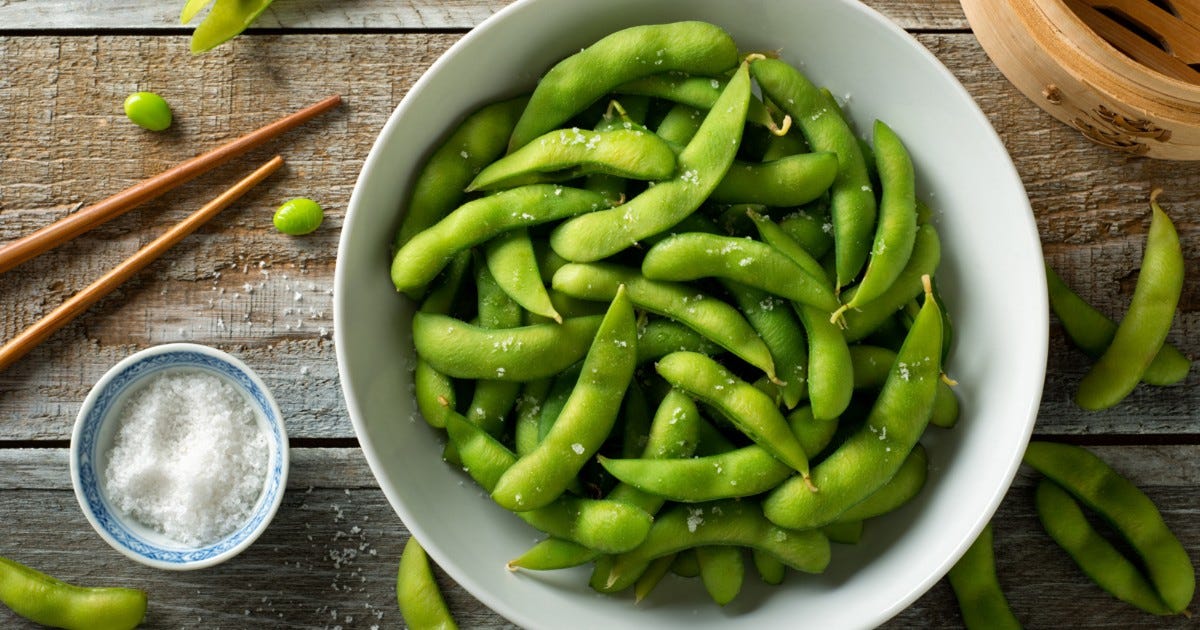
SOYBEAN: EDAMAME
(Glycine max)
Soybean is a major crop in the U.S. They are marketed for various purposes, including animal feed, edible oils, food products like tofu and soy milk, and non-food applications. In the home garden, the principle type of soybean grown is the bean called “edamame,” a tender bean almost always served in the pod and usually quickly steamed/poached and served salted (along with a can or glass of Asahi, Kirin, or Sapporo). Shelled edamame is used in salads, stir-fries, and soups.
Although there is a type of soybean that is designated “green soybean,” it is not the only source of edamame. Edamame are simply soybean pods picked at an immature stage (typically just 35 to 40 days after the crop first flowers) from any of several soybean types. These young soybeans contain more sucrose (hence sweeter) than mature soybeans (which have developed the starchier carbs) and more glutamic acid (one natural version of MSG), which decreases as the pods ripen.
THE OTHER TYPES, BRIEFLY
Green soybeans — the peel (the coat on the individual bean) of this soybean is green. It is often used to manufacture soy flour (“kinako”) or to simply simmered.
Yellow soybeans — the most common in terms of production quantity and varieties. Most processed soy products such as miso, soy milk, tamari, tempeh, and tofu come from this type. Soybean oil is made almost exclusively from yellow soybeans. It’s also another source of soy flour.
Black soybeans — generally used to make fermented black beans (the key ingredient in “black bean sauce,” of course) and simmered soybeans, which are often eaten as a part of the traditional Japanese New Year meal.
There are also white, red, and brown soybeans, as well as Kurakake soybeans (green and black).
Roasted soybean flour (“kinako”) is produced by grinding roasted soybeans into a powder. It’s commonly used for coating sweet or savory dumplings as well as for coating various confectionery.
Soybean/Edamame grows best in climates with long, hot summers, but several newer varieties do well in short seasons. As with all legumes, they do better when inoculated with a symbiotic bacterium; in the case of soybeans, it must be Bradyrhizobium japonicum, available commercially.
.
BLACK-EYED PEA
(Vigna unguiculata ssp. unguiculata Unguiculata Group)
Also known as Crowder Pea and Southern Pea, this is grown to the shelling and/or drying stage. It needs heat but is worth trying in cooler-summer gardens; for these gardens, try ‘California Buckeye #5’, ‘Fast Lady Northern’, and ‘Pinkeye Purple Hull’.
OLD HISTORY
Somewhere in tropical southern Africa, there was (still is) a bean now called Wild Cowpea (Vigna unguiculata ssp. dekindtiana). In its native range and just beyond, this wild species was selected for large seeds for eating fresh or drying; this is what is known today as subspecies unguiculata Unguiculata Group (this one, the Black-Eyed Pea). When it made it to Asia, humans selected out forms that developed edible pods eaten whole with tiny edible seeds; early on these were named the botanical subspecies sesquipedalis but eventually became what is now known as subspecies unguiculata Sesquipedalis Group (the sister, next, the Yard-long Bean).
Another form of Vigna unguiculata was selected out for animal fodder (formerly Vigna unguiculata ssp. textilis, now designated V. u. ssp. unguiculata Textilis Group). The common name Cowpea came from this group’s use as fodder, although it also got tagged onto Black-eyed Peas.
.
YARD-LONG BEAN
(Vigna unguiculata Sesquipedalis Group)
This humanly edible sister to black-eyed pea is the Asian-influenced edible-pod transfiguration. Also known as “asparagus bean” and Chinese long-bean.
Grows up to almost a yard long in long hot summer areas but usually only a foot to two feet everywhere else. Even short, it’s still quite edible, though. Short-season gardeners should consider ‘Akasanjaku’, ‘Liana’ (more vining), ‘Noodle King’, ‘Red Noodle’, ‘Stickless Wonder’ (“bush”), and ‘Yu Long Noodle’.
.
MUNG BEAN
(Vigna radiata)
Mung bean is a bushy plant, some being upright-bushy and some bushy-viney; plants vary from one to five feet in length. Mature seed colors can be yellow, brown, mottled black or green, depending upon variety. It is quite drought tolerant.
Whole cooked mung beans are generally prepared from dried beans by simmering until they are soft. Once cooked, they become light yellow in color when their skins are removed. Most commonly, mung beans are used for sprouting.
.
ADZUKI BEAN
(Vigna angularis)
Also spelled and called azuki bean, aduki bean, red bean, or red mung bean. The many varieties most familiar in East Asia have a uniform red color, but there are white, black, gray, and variously mottled varieties.
It’s an annual vine requiring a very long, warm season, the kind of climate where big watermelons grow best. In shorter-season areas, they can be started indoors in deep biodegradable pots to get a head start. They need a well-drained soil and consistent moisture.
.
GARBANZO BEANS, CHICKPEAS
(Cicer arietinum)
This is one of the oldest cultivated crops, having been grown in the Fertile Crescent some 10,000 years ago. The most common type of chickpea is the kabuli (kabuli chana in Hindi). It is large and tan-colored, with a fairly smooth coat. It was introduced to India in the 18th century from Afghanistan.
Dried chickpeas are ground into flour, shaped in balls and fried as falafel, made into a batter and used to coat vegetables before frying, baked to make farinata or socca, or fried to make panelle (a chickpea fritter from Sicily). Hummus is the Arabic word for chickpeas; when they are cooked, ground into a paste, and then mixed with tahini (sesame seed paste), it is called ḥummuṣ bi ṭaḥīna. We call it simply hummus in English. Garbanzo is the Spanish word; Italians call it ceci.
Dried chickpeas can take 1 to 2 hours to cook; less time if soaked 12 to 24 hours beforehand or if prepared in a pressure cooker. Fresh chickpeas, uncommonly eaten in the U.S., can be cooked in a rolling boil for 10 minutes and then simmered for an additional 20 to 30 minutes.
In some processes to make chickpea flour, there is a liquid byproduct called aquafaba. This is used as an egg white replacement to make meringue or ice cream. The liquid in canned chickpeas makes a decent substitute.
Chickpeas are summer growers, but they will grow well during cool weather, albeit with lower bean output. Chickpea plants are soft, floppy “bushes,” not vines.
.
WINGED BEAN
(Psophocarpus tetragonolobus)
It has many common names in addition to winged bean; two I like a lot: dragon bean and princess bean.
A vine taller and larger than common beans. The pod is rectangular in cross-section with four wings with frilly edges running lengthwise. The color may be cream, green, pink, or purple. Like soybean in both use and nutritional content; most think the flavor is akin to asparagus. Very tender. The entire winged bean plant is edible including the pods, seeds (must be cooked 2 to 3 hours), leaves, flowers, and tubers. Two varieties/types: ‘Urizun’ and “Hunan.”
.
INOCULANTS
Don’t forget that beans are legumes. As such, they are capable of taking nitrogen from the air, turning it inside out, and putting it into the soil in a form that can be absorbed by the plants. That takes a special friend, a symbiont, that lives in the roots of the plant. The many beans use various specialized bacteria as their symbionts and these bacteria must be in the native soil or they must be applied to the seed at time of sowing. If you have not successfully grown legumes in your garden similar to the species you plan to sow, buy an inoculant. Check with the seed company from whom you’ve purchased your seed or talk with a specialist with your County Cooperative Extension office to make sure you get the appropriate inoculant.
.
WHY DO BEANS MAKE YOU TOOT?
It’s the special fiber. Backing up a bit: monosaccharides — simple sugars — get into your system quickly, with no holdup in your gut. Typical polysaccharides are a whole bunch of sugars (called “carbohydrates” at this level of complexity, even though it’s sometimes just one type of sugar) all tied together; it doesn’t take much to break these down, though, so they can move from your gut into your system fairly quickly (semi-slowly). The special fiber (carbs) that beans contain is oligosaccharides, a carb group that contains just a few components but within those few components is a particularly interesting one: raffinose.
Raffinose, overall, is an exceptionally healthy carb (a complex sugar unto itself). It’s found, at various levels, in cabbage, Brussels sprouts, broccoli, asparagus, onions, leeks, Jerusalem artichoke (aka sunchokes), a few other vegetables, whole grains, and, of course, beans. Dried beans, especially, are super high in raffinose. It breaks down very slowly (sometimes not fully), hanging around in your gut for a while. During that time, it feeds your gut microbiome. Yep, it’s a prebiotic that’s especially good at promoting growth of lactobacilli and bifidobacteria.
The flip side of the raffinose coin is that the slow breakdown process (fermentation) leads to a few byproducts: hydrogen, carbon dioxide, and methane. Those are gases! And one of them is unpleasant. The microbiome within human tummies varies considerably; while some do a pretty good job of keeping the process unbothered; others can have a rougher go of it.
So what do you do if you want to eat beans but don’t want to be a social disturbance?
Simple answer: eat more beans. Pretty much everyone needs to eat more fiber.
There’s a couple of interesting truths here to work with:
Not everyone gets all that gassy from eating beans (or onions, broccoli, Jerusalem artichokes, et al).
There’s no good evidence that adding epazote, bay leaf, baking soda, fennel seeds, or the too many more such recommendations, actually work, at least not for everyone. Nor any consistent data that soaking the beans for hours or rinsing canned beans has anything more than minimal impact.
What does work, for most: Start with small amounts of beans (try different kinds) and gradually increase your consumption over time. This allows your digestive system to adjust to the increased fiber and carbohydrates in beans (or any high fiber addendum). While you’re at it, increase your water intake.
So eat your beans with every meal!
* The growing details (by those who do it in detail):
© Copyright, Joe Seals, 2025


